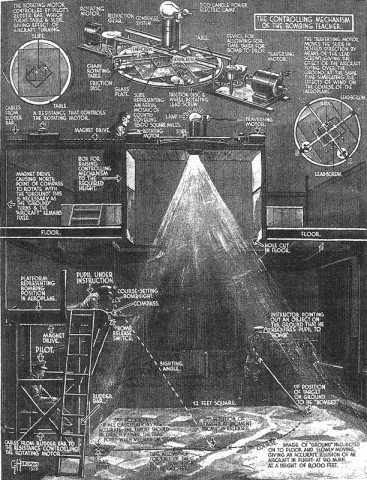
A great image found by @100YearsAgoLive of ‘bombing by wireless’ in 1921:
The question of aerial armaments will be discussed at the Washington Conference, and it is as well for us, while hoping for the best results from the conclave of the nations, to realise some of the terrifying developments in aerial warfare to which scientists are devoting attention. Shown here is a flying bomb, fitted with small wings and a motor, which can be steered by wireless so as to drop on the desired objective. One has only to remember the work done by wireless-controlled boats in the War, to realise in the flying bomb a terrible weapon, the construction of which, at all costs, must be avoided.((Globe (London), 3 December 1921, 15.))
This was not a new idea (ideas almost never are) but the specific impetus here, apart from the Washington Naval Conference which had begun in October — and which, as far as I know, did not discuss pilotless aircraft — seems to be a curious report of a new ‘flying bomb’ being tested over New York. This story of ‘a mechanically controlled flying torpedo’, for example, appeared in the Portsmouth Evening News the day before the Globe illustration:
Launched from an aerodrome near New York, this winged torpedo, which is known to be driven by an aero-engine, but the construction and control of which are still shrouded in mystery, is stated to have risen to a pre-determined altitude. Then it is said to have moved, invisible from the earth, against a head wind from one side of New York to the other, demonstrating that, if used in numbers in war and filled with incendiary matter, poison gases, and high explosives, great cities would like at the mercy of such an air craft.((Evening News (Portsmouth), 2 December 1921, 4.))
This flight was said to have ended unexpectedly ‘near a small town in Eastern Pennsylvania’, but overall ‘nearly a hundred test flights’ were made.((Ibid.))

The details are garbled (or invented), but this must be the Curtiss-Sperry N-9 Flying Bomb (above, in 1918, on automobile launcher), which was both test-flown in New York (at Amityville, Long Island) and made nearly one hundred flights (albeit usually with a human on board). So that fits. But I can’t find anything about any flight over New York City, though many accounts note one machine flew out to sea and was never seen again. More importantly, experiments with the N-9 seem to have ceased in January 1919, when the US Navy ended Sperry’s contract. The Navy apparently did continue some experiments with pilotless aircraft into the early 1920s, but not in New York.
As I can’t find any contemporary reports of this story in Chronicling America (or Gale NewsVault), it seems like that for some reason it resurfaced from the war years, or perhaps more likely was resurfaced for scaremongering purposes during the Washington conference. By whom I don’t know, but at least we got a lovely image of a cloud of wireless flying bombs about to rain death and destruction upon one of the world’s great cities.
Image sources: Globe (London), 3 December 1921, 15; Cradle of Aviation Museum, Garden City, NY.
![]() This work is licensed under a Creative Commons Attribution-NonCommercial-NoDerivatives 4.0 International License.
Permissions beyond the scope of this license may be available at http://airminded.org/copyright/.
This work is licensed under a Creative Commons Attribution-NonCommercial-NoDerivatives 4.0 International License.
Permissions beyond the scope of this license may be available at http://airminded.org/copyright/.




Another gem
Thanks, Adrian!